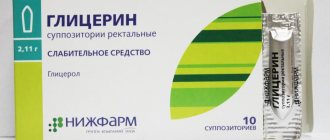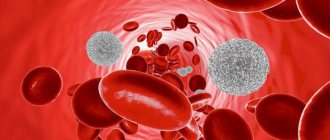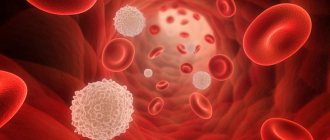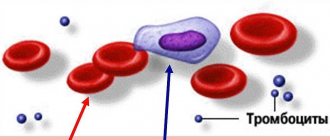Is it normal to have an increase in white blood cells after childbirth?
The famous healer Asclepius called childbirth a miracle ascending to God. This is truly an amazing phenomenon that accompanies a woman in labor with many extraordinary processes. Some of them accompany her, helping her adapt to the new status of the mother, others, on the contrary, can complicate her health, cause undesirable moments in the body, negatively affecting not only the woman herself, but also her baby. Among such phenomena, doctors include the phenomenon when women have increased leukocytes in the blood after childbirth for various reasons. This material is entirely devoted to this current topic, analyzing the reasons for such an increase, its potential risks, which will be a good information aid for many of our readers.
What symptoms should you pay attention to?
Many mothers face the problem of elevated leukocytes in the blood after childbirth. Reviews from doctors indicate that in most cases, such changes in the blood count are associated with stagnation of milk or infection of the ruptures.
In itself, an increase in the number of white cells in the blood only indicates inflammation. But the accompanying symptoms can clarify the picture:
If you notice such symptoms, you need to contact your gynecologist as soon as possible.
Leukocyte norms after childbirth
White blood cells, called leukocytes, play a vital role in the human body. So, they are designed to fight all kinds of bacteria, viruses, and other pathogenic factors. Reacting to the real situation, the bone marrow produces a certain number of leukocytes. If a person is healthy, their number reaches a colossal value - from 4 to 9 x109 per liter, that is, in the range of 4 - 9 billion. Deviation from this range often means that the protective mechanism of the immune system, for various reasons, begins to perform its functions not fully. There are also standards for the postpartum period of a woman. It is generally accepted that after the birth itself, leukocytes should return to normal within a day, reaching the established indicator for them - 9x109, that is, approximately 10 billion per liter of blood.
What are leukocytes needed for? General description and main functions
Leukocytes, called white cells, are a whole group of human blood cells. By the way, it is not by chance that they are called white - they do not have their own coloring.
The main function of these structures is protection. Leukocytes are capable of movement and can penetrate into the intercellular space through the capillary wall. These cells absorb foreign particles (including pathogenic structures), neutralizing and digesting them.
Normally, the level of leukocytes in the blood of an adult woman ranges from 4-9·109/l. If after childbirth this indicator changes, this may indicate an inflammatory process.
Reasons for the increase
Doctors have designated an increased, against the norm, number of leukocytes in human blood with the term “leukocytosis.” Its presence, as a rule, signals that a person has quite serious health problems. Such ailments may include:
- Inflammatory processes of tissues and organs.
- Postpartum, postoperative, other complications.
It is also worth noting that after childbirth, leukocytosis can take both a false and pathological form. The reasons why the number of white blood cells increases are different. Their basis is an extreme mode of functioning of the female body, focused on maximum protection of the baby. Therefore, a larger number of white blood cells than normal are produced. Experts consider increased physical activity and breastfeeding to be safe reasons for the increase in white blood cells. The level of white cells also increases during stressful situations, which are very undesirable for a weakened postpartum female body.
Leukocytes - why is it so important to know about them?
Leukocytes are white blood cells that are the first to respond to microbes and infections entering the body. Their main function is protection. When foreign agents are detected, the body increases its production to detect and destroy them. If the level of white cells increases, this is a signal that there is an inflammatory process in the body.
A healthy adult has 1000 times fewer leukocytes than red blood cells. But their number is not constant - it varies slightly for various reasons. For example, their levels increase slightly in the evening or after eating.
A persistent or significant increase in cells signals a focus of inflammation, possible blood problems, or complications after childbirth or surgery.
Neutrophils are a type of leukocyte that is responsible specifically for neutralizing pathogenic pathogens. They absorb harmful cells and die in the process (actually, pus is destroyed neutrophils). Therefore, when assessing a blood test, you need to pay attention to this indicator.
When does physiological leukocytosis occur?
The root causes of an increase in the leukocytes of a woman who has given birth listed above are also supplemented by other factors. So, the reasons why the level of postpartum leukocyte count increases may be:
- Visiting a sauna or steam bath.
- The threshold of menstruation.
- Consumption of certain specific foods that are undesirable for a young mother, and other points.
If, on this basis, leukocytosis is observed in a woman who has given birth, it is physiological in nature and, as a rule, does not represent serious prerequisites for the occurrence of disease or infection. However, its presence should serve as a signal for a thorough examination by specialists so that things do not turn into pathological leukocytosis.
Pathological leukocytosis
In practice, leukocytosis after childbirth of a more serious nature, called pathological in medicine, is often recorded. It differs from the physiological one by the constant growth of white blood cells, confirming, most often, the presence of a number of characteristic diseases. Among them are:
- Acute inflammation.
- Heart attacks of one or another internal organ.
- Blood deficiency caused by bleeding.
- Deviations in the functioning of the renal and other body systems.
In women after childbirth, it can also begin due to inflammation of the uterus or breasts, mastitis, and inflammatory processes of the genitourinary system.
Why violations occur
It is important to understand why the violations occurred and whether there is a way to resolve everything. An experienced doctor is able to figure out what is in front of him: pathological or false leukocytosis after childbirth.
Factors influencing the pathological condition will be:
- Heart attack or heart problems.
- Inflammation of the waters around the fetus.
- Disturbances in the functioning of internal organs.
- Suppuration of tissues.
- The presence of infections acquired through wounds, scratches and damage.
- Sepsis or septic shock.
- The presence of placenta and membrane particles in the uterine cavity.
The occurrence of a false diagnosis is usually influenced by:
- Taking a hot water bath or shower the day before, visiting a bathhouse or sauna.
- Breastfeeding the baby.
- Intense physical training or exercise.
- Excess protein foods in the diet.
Among the generally accepted reasons and additional influence factors are:
- anemia;
- avitaminosis;
- chronic diseases;
- surgical interventions;
- weakened immune system;
- large blood loss;
- poor clotting;
- cracked nipples.
Read also: How quickly the uterus contracts after childbirth: the sensations are normal
When to sound the alarm and see a doctor
In itself, an increase in white blood cells after childbirth is not particularly dangerous for a woman, but, of course, it should not be ignored in any case. For her, signs of abnormal processes in the body include symptoms of general weakness, excessive sweating, fever and other discomfort.
Regardless of what caused leukocytosis, you must immediately consult a doctor and take effective treatment measures, which should only be prescribed by an experienced specialist. Sometimes patients resort to self-medication using various folk recipes, however, even in this case, preliminary consultations with a gynecologist should be mandatory.
Why are leukocytes in the blood elevated after childbirth?
Pregnancy and childbirth have different effects on a woman's condition. During the postpartum period, changes occur in the body that affect both psychological and physiological levels. If leukocytes in the blood are elevated after childbirth, you need to undergo a thorough examination.
Read also
What does the MCHC level in the blood indicate and why does it change?
Pathology: symptoms
• large blood loss;
• inflammatory process in the uterus;
• inflammatory process in the genitourinary system;
• general malaise and weakness;
Any woman in labor needs to understand that childbirth is a strong test for the body. After pregnancy, a woman is often weakened. This can cause the development of various diseases. You need to take blood and urine tests after childbirth, and also come to see a gynecologist. You need to carefully monitor your own health during the postpartum period. If pathology develops, the doctor will conduct a full examination of the woman and prescribe the necessary treatment for the disease.
The tiny creature of the first days of life seems so fragile that many parents feel a slight attack of panic when the need arises to take the child in their arms.
The most important rule is to set yourself a goal - to constantly improve your knowledge about your baby and your ability to care for him.
The most important condition for setting the deadline, of course, is the individual characteristics of the organism.
Symptoms of deviations
Leukocytosis is not a separate pathology, therefore, when it occurs, the symptoms of the underlying disease predominate. Specific signs may include:
- general weakness and feeling of fatigue that does not disappear after a long rest;
- increased body temperature;
- disturbance of consciousness;
- dizziness;
- decreased appetite;
- enlarged and painful lymph nodes;
- decreased visual acuity;
- frequent occurrence of nose and gum bleeding.
If one or more signs are detected, it is necessary to consult a doctor and undergo an examination to help identify the reasons why white blood cells increased after childbirth.
Treatment options
In this situation, it is important not to panic and consult a doctor promptly. The examination will make it possible to make the correct diagnosis and begin treatment. A specialist may suggest the following methods:
- Taking medications to lower uric acid levels prevents tissue destruction.
- Taking antibiotics prevents sepsis and treats bacterial infections.
- Steroids - reduce or relieve inflammation.
Normal level
White blood cells are essential for fighting bacteria, viruses and other pathogens. Depending on the condition of the body, the bone marrow produces a certain number of white blood cells. The normal level for a healthy person is 4-9 billion/l.
A deviation upward or downward indicates the presence of an inflammatory process or a dysfunction of the immune system.
The norm of leukocytes after childbirth can reach 10 billion/l. Over time, this figure decreases.
Why deviations occur
Leukocytosis after childbirth does not always indicate the presence of a dangerous disease. In most cases, the phenomenon is temporary and caused by physiological reasons. Non-hazardous provoking factors include:
- increased physical activity (the body weakens after childbirth, which is why even usual household chores can negatively affect a woman’s condition);
- stress (an increase in the number of leukocytes can be facilitated by lack of night sleep, changes in the rhythm of life, psycho-emotional overload);
- breastfeeding (lactation can cause a temporary change in blood composition);
- eating before donating blood for analysis (the procedure must be carried out on an empty stomach);
- visiting a sauna or bathhouse, taking a hot bath;
- the upcoming onset of menstruation (leukocytosis is caused by a sharp change in hormonal levels observed when breastfeeding is stopped).
Physiological leukocytosis is not associated with infections or inflammatory diseases; this condition does not pose a threat to a woman’s health. A pathological increase in leukocytes in a woman’s blood after childbirth is characterized by a constant increase in the indicator, detected during repeated tests. The reasons for this condition include:
- acutely ongoing inflammatory processes in the upper respiratory tract (leukocytosis can be triggered by ARVI, tonsillitis or sinusitis, often worsening in the postpartum period);
- impaired blood supply to internal organs (accompanied by tissue breakdown with the subsequent development of an inflammatory process, to which the immune system responds with increased production of leukocytes);
- chronic diseases of the excretory system (in late pregnancy and after the birth of a child, pathologies such as chronic cystitis and pyelonephritis often worsen);
- massive blood loss (can be caused by premature placental abruption, rupture of the uterus and perineal tissue during childbirth);
- decreased or increased blood sugar levels;
- ruptures of cerebral vessels caused by difficult childbirth;
- suppuration of the surgical wound after cesarean section or sutures applied after dissection of the perineum;
- inflammatory processes in the tissues of the mammary gland (lactostasis and mastitis caused by milk stagnation);
- postpartum endometritis (inflammation of the uterine mucosa that occurs when tissue becomes infected);
- oncological diseases (pregnancy and childbirth can provoke metastasis of the tumor, accompanied by changes in blood composition).
Low leukocytes in the blood of women - what does this mean?
Good afternoon, dear Elena Petrovna! Please tell me whether an increased level of leukocytes in the blood during the postpartum period (3-4 days after birth) is normal. I can’t find information about this through a search. Thank you very much!!
p.s. Girls, if possible, share the link so as not to occupy the Doctor’s attention with this issue.
A woman's body is most vulnerable during the first period after childbirth. Having endured enormous stress during pregnancy and after childbirth, he may be especially susceptible to the emergence of various diseases. Leukocytosis after childbirth is a very common occurrence. Leukocytes perform a protective function in the body. They are an important part of the immune system.
There are two types of leukocytosis: physiological and pathological. The first of them occurs against the background of normal processes occurring in the body. Pathological leukocytosis indicates the presence of inflammation. What processes are indicated by an increase in leukocytes in a blood test? How to recognize a type of leukocytosis? You can find out more by reading the article further.
This type of leukocytosis is most likely during pregnancy and breastfeeding. At this time, all processes in a woman’s body proceed differently. After the baby is born, tests should show a leveling off, but often this does not happen. Elevated leukocytes in the blood after childbirth are often detected, since labor is a powerful stress for the body. In order to resist it, the body increases the production of white blood cells.
Why the white blood cell count may increase:
- lactation;
- constant physical activity;
- stress;
- second and third trimester of pregnancy;
- going to the bathhouse;
- period 2-3 days before the onset of critical days;
- non-compliance with the rules for taking tests.
An increase in leukocytes in the blood for these reasons is considered normal. If a high content of white cells is detected in the blood, the doctor will prescribe a control test, the results of which will confirm or refute the preliminary diagnosis. The lack of dynamics indicates that there is no inflammatory process in the body.
Note! A distinctive feature of physiological leukocytosis is the absence of accompanying symptoms. Apart from an increase in the number of white cells in the analysis, this condition does not manifest itself in any way.
There is such a thing as false leukocytosis of pregnant women. The immune system provides enhanced protection to the fetus, therefore increasing the concentration of leukocytes in the blood. It refers to physiological processes. However, if during pregnancy the concentration of leukocytes constantly changes and other signs of inflammation are present, such an ailment should be considered pathological.
What do constantly increasing numbers of leukocytes indicate? This process indicates the presence of true leukocytosis.
The reasons for its appearance can be varied:
- kidney infection;
- inflammatory processes in the reproductive system;
- inflammation of the genitourinary system;
- inflammation of the mammary gland;
- inflammation of the inner layer of the uterus.
Women in labor often experience pathological leukocytosis after childbirth due to these factors. During pregnancy, all systems and organs are subject to increased stress. During childbirth, tension reaches its limit and can provoke the onset of an inflammatory process. Inflammation of the kidneys, genitourinary and reproductive systems can be prevented by taking preventive measures.
A pregnant woman should visit a doctor in a timely manner, take all tests and report changes in her health. In addition, there are some simple exercises to avoid postpartum complications. For example, to prevent pyelonephritis, it is recommended to stand in the knee-elbow position every day and stay in it for at least 15 minutes. It should be performed several times a day. There is a high risk of mastitis in a nursing mother.
Breasts are very vulnerable during lactation, which is why it is so important to preserve them. A small draft can lead to serious inflammation. It will be impossible to continue feeding as it will cause severe pain. In addition, the mother will require treatment that cannot be combined with breastfeeding.
It is important! Women who have had a cesarean section are at greater risk of developing an infectious disease. If basic hygiene rules are not followed, an infection can be transmitted through the suture into the bloodstream.
Until the cervix closes, this part of the body will also be at increased risk. Failure to maintain personal hygiene can lead to endometritis. With pathological leukocytosis, there is a constant increase in the number of leukocytes in the blood test. In addition, signs such as pain in the area of the affected organ, increased body temperature, chills, weakness, and dizziness may be observed.
Leukocytes are particles with which the immune system fights disease. Their increase signals the presence of a disease. Pregnant and lactating women must be observed by a doctor and periodically have their blood tested. Such measures will allow you to notice the inflammatory process in time and prevent its spread.
Leukocytes in a woman’s blood, both during pregnancy and after childbirth, are the main indicator of the health of the mother and her baby. The fact is that these blood elements are responsible for the protective function of the body - they are responsible for immunity. Moreover, their number constantly changes depending on various factors, including during pregnancy.
— food poisoning;
- inflammation in the liver or kidneys;
— stress and psycho-emotional disorders;
- excessive physical activity;
- long-term use of certain medications.
Sometimes, if leukocytes in the blood are elevated after childbirth, we are talking about false indicators. Therefore, repeat tests are required periodically. In other words, a postpartum increase in leukocytes in the blood can be both a physiological norm and evidence of the development of diseases in the body.
- during pregnancy;
- after increased physical activity;
- after childbirth while breastfeeding;
- after taking a bath;
- after eating;
- infarction of the lungs, kidneys, spleen or heart;
During gestation, monitoring the composition of the blood in general, and white cells in particular, should be especially careful. During pregnancy, leukocytes in the blood are responsible for the formation of immune defense mechanisms for the mother and the developing embryo from pathogenic agents of microorganisms. White leukocyte cells inactivate allergens and prevent the development of oncological pathologies.
What are the reasons for the increase in leukocytes in the blood of pregnant girls? Bearing a fetus is a normal physiological position for a woman, why there are high leukocytes in a woman’s blood during pregnancy, the reasons may be:
- Physical activity is steadily increasing;
- Concerns about the health of the unborn child can create stressful situations;
- Unbalanced diet: excess carbohydrates, hot or cold temperature of food served;
- Room temperature is too low or high;
- Blood thickening due to hormonal changes;
- Overeating on the eve of blood sampling for research;
- Stressful state before donating blood.
One way or another, if the results of a blood test show leukocytosis in a pregnant woman, then the studies are duplicated.
Changes in blood counts during pregnancy
If a blood test shows an excessively high level of white cells, repeat tests are prescribed. In the case of ongoing and developing leukocytosis, additional studies are carried out to determine the cause of the increase in leukocytes during pregnancy in a woman:
- Viral infections or bacterial etiology with the development of clinical symptoms of acute respiratory disease, pyelonephritis, hepatitis, bronchopneumonia;
- Suppuration: abscesses, peritonitis, sepsis;
- Inflammation of non-infectious etiology;
- Allergic conditions;
- Angina pectoris, anaphylaxis;
- Rheumatoid arthritis and other pathologies in which the body rejects its own cells, mistaking them for foreign;
- Burns, wounds, injuries;
- Heavy bleeding;
- Thrush;
- Cancerous tumors.
It is no secret that in the postpartum period a woman may face various health problems. In order to promptly detect and treat postpartum complications, it is necessary to carefully monitor your health and regularly submit biological materials for research. One of the most common phenomena after childbirth is a jump in white blood cells. What does the biological analysis say, and why do leukocytes increase after childbirth?
Leukocytes are white blood cells that contain special enzymes.
Leukocytes can move freely and are the basis of the body's immune system.
The number of leukocytes is a key indicator of blood; normally in women their number is 3.2–10.2 × 10 to the 9th power.
- Degree of fatigue;
- Time of day: in the evening the number of white cells increases;
- Psycho-emotional state (anxiety, apathy, irritability);
- Is the stomach empty or full: after satiety, the level of white cells increases.
How to normalize
Compliance with the following recommendations helps to normalize indicators for physiological leukocytosis:
- organizing a proper work and rest regime (after childbirth, a woman should rest as much as possible, which is necessary to restore normal immune function);
- proper nutrition (fatty, fried and spicy foods are excluded from the diet, fresh vegetables and fruits, dietary meats, and dairy products are healthy);
- taking vitamin supplements prescribed by a doctor;
- exclusion of heavy physical activity (some of the housework should be entrusted to relatives);
- adherence to a breastfeeding regimen that does not allow stagnation of milk.
Read also
Diagnosis and complex treatment of systemic scleroderma
The method of treating pathological leukocytosis is selected depending on the type of underlying disease. There is no remedy that reduces elevated white blood cells. The treatment regimen may include the following drugs:
- Antibiotics (Cefazolin, Amoxiclav). Most often, the number of white blood cells increases due to infections. Antibacterial and anti-inflammatory drugs help eliminate the cause of leukocytosis and normalize blood composition.
- Hormonal agents (Dexamethasone). Used in the treatment of allergic reactions accompanied by an increase in the number of white blood cells. Therapy is supplemented with non-hormonal antihistamines (Suprastin). Breastfeeding is stopped during treatment.
- Chemotherapeutic agents. Such drugs are prescribed for leukocytosis caused by cancer of the hematopoietic system. Cytostatics suppress the division of cancer cells, slowing tumor growth.
General characteristics
White cells in the blood are designed to protect the body from external influences from foreign microorganisms. They carefully examine the condition of every organ, cell, and tissue and, having identified danger, mercilessly destroy strangers or their own degenerated cells. These unique abilities of leukocytes form the human immune defense.
They instantly respond to favorite changes in the body. Therefore, in addition to pathological factors affecting the level of white cells, there are simple explanations for the physiological increase in leukocytes in the blood. In addition to eating, exposure to elevated temperatures, psycho-emotional and physical stress, such reasons include childbirth.
General concepts
White cells in the blood are designed to protect the body from external influences from foreign microorganisms. They carefully examine the condition of every organ, cell, and tissue and, having identified danger, mercilessly destroy strangers or their own degenerated cells. These unique abilities of leukocytes form the human immune defense.
They instantly respond to favorite changes in the body. Therefore, in addition to pathological factors affecting the level of white cells, there are simple explanations for the physiological increase in leukocytes in the blood. In addition to eating, exposure to elevated temperatures, psycho-emotional and physical stress, such reasons include childbirth.
White blood cells are called leukocytes. They protect the body from the negative effects of viruses and bacteria. These cells have the ability to promptly recognize a foreign microorganism in the human body and eliminate it.
There are several types of leukocytes, and they all form human immunity. It is by the level of these cells that a specialist can judge the patient’s health status.
With any changes in the state of the body, the level of white cells increases.
This may happen:
- at high ambient temperatures;
- after eating a significant amount of food;
- for any overload - emotional and physical;
- during pregnancy and after the birth of the child.
Such increases are called physiological.
More dangerous is the increase in the concentration of leukocytes in the blood, which occurs due to infection in the body.
That is why the study of leukocytes is a standard diagnostic test. This procedure helps to detect in time the presence of serious pathological processes in the body, which is very important, especially in the postpartum period. Women in this position are advised to undergo periodic tests.
White blood cells protect the body by phagocytosis - the absorption and digestion of pathogenic microorganisms of various sizes, as well as by stimulating the immune system - the production of specific antibodies that directly interact with the causative agent of the disease.
Determining the number of white cells is the first step in diagnosing any pathology. A general blood test determines the total number of leukocytes. However, if there is a deviation from the norm, it is necessary to use a more detailed research method that allows you to determine the concentration of each cell type separately. For this purpose, an analysis is carried out to decipher the leukocyte formula, carried out by flow cytometry.
Determining the size of each type of white blood cell allows you to more accurately determine the causes of the disease, since each type of cell performs a specific function:
- neutrophils carry out phagocytosis of relatively small particles. After their death, cells release a significant amount of biologically active substances, enhancing the response of the immune system;
- lymphocytes are capable of synthesizing antibodies that neutralize pathogens and their toxins. In addition, they control the functioning of other cells of the immune system;
- Monocytes destroy large numbers of small foreign bodies or large pathogens using phagocytosis. A distinctive characteristic is the ability to perform a protective function even at acidic pH values, when neutrophils lose their antimicrobial activity;
- eosinophils implement antiparasitic defense of the human body, and also take a major part in the development of an allergic reaction;
- basophils promote the influx of white blood cells into the site of inflammation through their own degranulation, which results in the release of a large number of mediators of allergy and inflammation.
Physiological causes of postpartum leukocytosis
Labor is a natural process. The body prepares for it in advance. To prepare for significant blood loss, the process of hematopoiesis is enhanced. In addition, white blood cells accumulate in the uterine area to prevent infection and stimulate uterine contractions. Therefore, at the time of birth, leukocyte counts can exceed the norm by 20% and reach up to 12x10^9 particles per liter.
Already at the beginning of labor, the level of leukocytes increases rapidly and amounts to 30x10^9 per liter.
The process of childbirth itself is a huge stress, having both physical and psychological origins. This factor also provokes a physiological increase in white cells.
After childbirth, the recovery period is accompanied by increased formation of blood particles and healing of damaged tissue, which explains the increase in the level of leukocytes.
Leukocytosis against the background of active hematopoiesis is observed in women who have lost a lot of blood during childbirth, as well as as a result of cesarean section. Blood counts are restored 3–5 days after delivery.
Risk factors
As you know, inflammation is the result of the activity of bacterial microorganisms. As a rule, these are opportunistic bacteria, in particular, staphylococci, streptococci, E. coli, etc. They are always present in the body, but their reproduction processes are activated against the background of stress, which is the birth process, as well as when the immune system is weakened. Risk factors include:
Deviations from the norm
If significant deviations from the norm are observed, which are in the range of 4–9x10^9 cells per liter, or they do not decrease to normal within 5 days, postpartum complications are suspected.
Leukocytosis in the postpartum period is a sign of infectious and inflammatory complications. Microbes are activated due to the following factors:
- blood loss during childbirth;
- weakened immunity;
- vitamin deficiency;
- anemia;
- disturbances in the process of blood clotting;
- remnants of membranes, placental tissue in the uterus;
- surgical interventions during childbirth;
- cracked nipples;
- long anhydrous interval during childbirth;
- severe pregnancy, childbirth.
Leukocyte counts in the postpartum period are increased with the following pathologies:
- With postpartum endometritis - inflammation of the uterine cavity.
- During chorioamnionitis - inflammation of the amniotic fluid.
- For postpartum mastitis - inflammation of the mammary glands.
- Due to lactostasis - stagnation of milk.
- With postpartum pyelonephritis - infectious and inflammatory damage to the kidneys.
- Due to postpartum cystitis - inflammatory damage to the bladder.
- For postpartum ulcers - infection of tears, cracks and abrasions.
- As a result of septic shock.
In addition to leukocytosis, inflammatory postpartum diseases are accompanied by fever. Postpartum complications require mandatory treatment. In some cases, such as septic shock, the life of the woman in labor depends on the speed of measures taken.
The manifestation of infectious and inflammatory complications may be delayed, so it is important for the mother in labor to monitor her condition and visit a gynecologist after returning home.
Leukocytosis in the postpartum period may be the first signal of pathological changes in the body. Therefore, listen to the recommendations of doctors, do not rush to leave the clinic as quickly as possible, but undergo additional examinations and antimicrobial therapy.
Read also
What tests need to be taken for hemorrhoids: names and descriptions
Leukocytes in the blood during pregnancy: normal, elevated, after childbirth, causes of leukocytosis – About Blood
Childbirth is a natural process, but still stressful for a woman’s body.
Weakness and some deterioration in well-being even after a normal birth are common occurrences. Young mothers rarely pay attention to their health at this time - they are absorbed in communicating with the baby. However, if the analysis shows that leukocytes in the blood are elevated after childbirth, you will still have to pay attention to this.
This may be both a normal phenomenon and a signal of the beginning of the development of pathology.
Leukocytes - why is it so important to know about them?
Leukocytes are white blood cells that are the first to respond to microbes and infections entering the body. Their main function is protection. When foreign agents are detected, the body increases its production to detect and destroy them. If the level of white cells increases, this is a signal that there is an inflammatory process in the body.
A healthy adult has 1000 times fewer leukocytes than red blood cells. But their number is not constant - it varies slightly for various reasons. For example, their levels increase slightly in the evening or after eating.
A persistent or significant increase in cells signals a focus of inflammation, possible blood problems, or complications after childbirth or surgery.
Neutrophils are a type of leukocyte that is responsible specifically for neutralizing pathogenic pathogens. They absorb harmful cells and die in the process (actually, pus is destroyed neutrophils). Therefore, when assessing a blood test, you need to pay attention to this indicator.
Normal level in pregnant women
During the period of bearing a child, the following are considered normal BC indicators:
- 1-3 months: 4 – 7x109/l,
- 4-6: 7.6 – 10x109/l,
- 7-9: 10.4 - 12 x109/l.
It is customary to talk about physiological leukocytosis - a temporary increase in white blood cells, which is considered a medical norm, and pathological - constant and dynamic, which is a sign of inflammation.
Physiological leukocytosis
Nature has provided many mechanisms to protect the fetus. One of them is leukocytosis. By the second half of pregnancy, the mother’s body is already weakened. The consumption of vitamins and nutrients actually costs two.
And the body adapts - it produces a large number of leukocytes that react to the slightest deviations and suppress the infection before it has time to develop.
Thus, the norm of leukocytes in the body of a pregnant woman is higher than that of an ordinary adult.
Leukocytosis persists for another 1-2 weeks after birth. After this period of time, your white blood cell count should return to normal.
The following reasons can cause an increase in neutrophil levels:
- Physical activity or stressful situations.
- Breastfeeding also often keeps white blood cell levels above normal.
- The beginning of the menstrual cycle is 1-2 days before menstruation.
- Visiting a bathhouse or sauna the day before the test.
- Donate blood on a full stomach.
If the test shows elevated white blood cells, it is recommended to take it again after a few days. If the level has decreased or at least not increased, we are most likely talking about physiological leukocytosis.
Pathological leukocytosis
If leukocytes after childbirth are higher than normal, or their level continues to increase, it is customary to speak of pathological leukocytosis.
In women in the postpartum period, pathological leukocytosis occurs as a reaction to the following conditions:
- Inflammation of the genitourinary organs.
- Large blood loss.
- Mastitis.
- Endometritis.
- Pyelonephritis.
With pathological leukocytosis, there are accompanying symptoms characteristic of inflammatory processes: chills, fever, and often pain and weakness. Bloody or purulent discharge may occur. If you have these signs, you should immediately consult a doctor.
Risk factors
In the case of a difficult birth, rupture, heavy bleeding or cesarean section, the young mother should be especially careful about her health. If a blood test reveals an increase in neutrophils, this may indicate:
- inflammatory process,
- remnants of the placenta in the uterus and the beginning of the inflammatory process,
- exacerbation of chronic diseases in the postpartum period,
- postpartum inflammation of the genitourinary system,
- disorders of hematopoietic function or blood clotting function,
- penetration of infection through cracks in the nipples.
During pregnancy, a woman’s body consumes a significant amount of vitamins and beneficial microelements. Elevated leukocytes can also indicate their critically low level.
How to normalize indicators
With elevated BC, the expectant mother may be prescribed:
- antibiotics, if a violation of the norm is a consequence of an infectious disease,
- a special diet if white blood cells are impaired due to liver problems.
Patients with low BC need:
- eat buckwheat, raw vegetables, red fruits, oats,
- Avoid products with animal fat, meat and liver.
How to avoid complications
A young mother should be attentive to any signals from her body. After giving birth, she is greatly weakened, her immunity is reduced, and to this is added the happy excitement of communicating with the baby.
Fatigue and systematic lack of sleep themselves can cause an increase in white blood cells - the body activates additional protection in order to avoid diseases during a stressful period of life.
But if after childbirth your white blood cells are significantly elevated, you should immediately consult a doctor.
Scrupulous adherence to personal hygiene and doctor’s recommendations is the first thing that will prevent diseases. Any ailments, strange discharge or painful sensations should be the reason for immediate contact with a specialist. Especially if this is accompanied by fever, chills and weakness.
At this time, you should not hope that “it will go away on its own” and think that the cause of the illness is a mild cold or lack of sleep.
It is recommended to take regular blood tests to monitor changes in white blood cell levels after childbirth. Even if there are no symptoms of inflammation, it is worth visiting a doctor if they grow steadily, or if the level does not return to normal after two weeks after birth.
Paying attention to your health will help you avoid many problems. Timely consultation with a doctor can save lives.
Source: https://donor08.ru/analizy-krovi/lejkotsity-pri-beremennosti-v-krovi-norma-povysheny-posle-rodov-prichiny-lejkotsitoza.html
What are leukocytes
Leukocytes are the colorless cells of the circulatory system, which are responsible for protecting the body from all kinds of infections. Defender cells move freely through the circulatory system and rid us of dead cells, infections, harmful substances and foreign bacteria.
These cells are popularly called white blood cells. The structure of leukocytes can differ from each other; they have an irregular shape and can be of different sizes.
An increase in the number of leukocytes in a person always indicates the presence of health problems. These can be inflammatory diseases of organs and tissues, blood diseases or postpartum, as well as postoperative complications.
Why does leukocytosis occur?
Doctors call leukocytosis an excess of leukocytes in the blood above normal. After pregnancy, both false and pathological leukocytosis can occur. During pregnancy, normal blood test values are slightly changed. During the period of gestation, a woman’s body works in extreme mode. All protective functions are activated to the maximum to ensure the safety of the baby. It is for this reason that a pregnant woman's body produces more white blood cells.
After childbirth, the normal number of white cells should return to normal. However, there are often cases when, when taking a test, a young mother is diagnosed with leukocytosis. This does not always mean that a woman has some kind of disease. In most cases, this indicates the presence of physiological leukocytosis.
A harmless increase in the number of leukocytes in the blood may be due to the following factors:
- Regular physical activity.
- Second half of pregnancy.
- Stressful situations.
- Lactation.
- Food intake (to obtain adequate indicators, the analysis must be taken on an empty stomach).
- Visiting the bathhouse, bath, sauna.
- 2–3 days before menstruation.
With physiological leukocytosis, the young mother is not at risk of infection or disease. If, when taking a blood test, you were told about an increase in leukocytes, there is no need to worry.
In order to exclude the development of diseases and postpartum complications, the analysis must be repeated after a few days.
If your white blood cell count does not increase, it is safe to say that you have benign leukocytosis.
What do the test results say?
There is a generally accepted norm of leukocytes after childbirth, which can be determined by analysis. For a detailed examination, the doctor usually prescribes blood and urine tests, and also takes a smear from the vagina. There is no need to talk about violations if:
- leukocytes in urine are 0.3 g;
- in the blood - no higher than 9*109 per liter;
- You can forget about elevated leukocytes in a smear if the indicators are no more than 0.14.
Smear
It should be remembered that elevated leukocytes in a smear after childbirth can be due to physical activity or consumption of large amounts of protein foods (meat, fish, chicken, eggs, dairy and legumes). A slight excess of up to 20 units is allowed in this situation and there is no need to panic. To understand the situation completely, doctors may prescribe additional tests, repeat the diagnosis at any other time, or pay attention to other symptoms of the disease.
If leukocytes are elevated in the smear after childbirth, this phenomenon may be accompanied by the following additional symptoms:
- disruption of the menstrual cycle;
- a feeling of burning and unpleasant itching of the genitals, often irritation;
- excessively frequent visits to the toilet, with pain and unpleasant symptoms;
- copious discharge.
Common causes of the disease may include:
- the presence of E. coli;
- possible infections (fungal);
- streptococcus or staphylococcus;
- cancer of the reproductive organs (or precancerous condition);
- vaginal dysbiosis.
Blood
This is normal during pregnancy (especially during the second and third trimester). This is due to a large accumulation of white cells near the reproductive organs; after the birth of a child, the likelihood of a similar phenomenon is also high, due to the difficult process of tissue restoration. Over time, the indicators return to normal.
Urine
Excesses may be observed in the urine after childbirth due to dysfunction of the kidneys. Test results ranging from 30 to 50 units indicate that additional kidney examination is necessary.
Do not forget that leukocytes in the urine may have higher levels due to improper analysis, insufficient water intake or adherence to a protein diet.
But you shouldn’t rule out the presence of kidney disease at this stage.
Read also: Anemia after childbirth: symptoms and treatment











